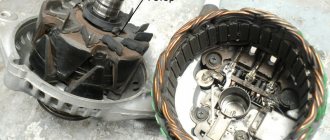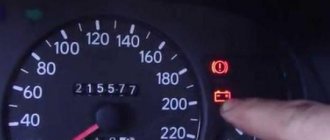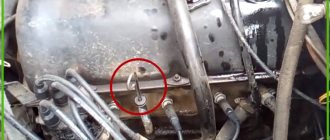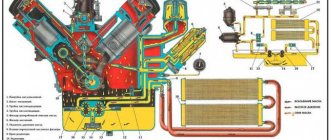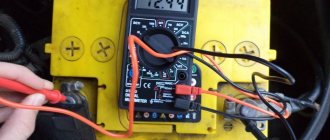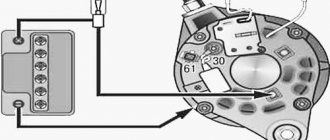Designation
Driver driving a car
When the battery light comes on during ignition, this means that the car’s generator is ready to operate. The light comes on after turning the key halfway in the ignition. When the engine is turned on, the indicator should go out. If the light comes on while the car is moving, this means that the generator is not working and the car is supplied with electricity only from the battery. If such a situation occurs, it is necessary to promptly correct the malfunction.
When using a car for a long time, drivers sometimes encounter a malfunction when the battery charge does not light up when the ignition is turned on - what are the possible causes of the breakdown?
It is worth noting that without the key and with the ignition off, none of the indicators light up.
This is interesting: If the battery in the alarm key fob runs out: how to turn off the siren that buzzes throughout the entire neighborhood
When the ignition is turned on, the battery charging light does not light up
I have a 1NZ-FE engine. The problem is that the battery light does not light up when the ignition is turned on. And now everything is in order. I recently replaced the Starline B9 alarm system with KGB 9, an analogue of Sherkhan 7. Installed by a special one. We connected the autostart to the tacho signal. The starter, when starting, either did not turn it up or overturned it. I didn’t like this, and I decided to switch the alarm from the tacho signal to the generator because only with this connection the starter is turned off after the engine starts. I found 31 wires in Fig. 1 from the book and connected.
I programmed the whitefish using the generator. When checking the auto start, it turned out that the starter does not turn off when the engine starts. That is, it works out the maximum operating time of the starter. It was only then that I discovered that the battery light on the instrument panel did not light up. I took the tester and started taking measurements according to Fig. 2. (I have a strong suspicion that the light hasn’t come on for a long time, and I can’t say when it went out).
Why is the light on?
From the moment the engine starts, the car battery is charged. The driver, by inserting the key into the ignition switch, thereby turns on the vehicle's on-board network. Further turning of the key activates the starter and starts the engine. If the light continues to light while the engine is running, indicating that the battery is charging, then most likely direct current is not reaching the generator. With this turn of events, the entire burden of supplying consumers with electric current is placed on the battery. In addition, the constant burning of a light bulb may indicate the following cases:
- Worn alternator belt or brushes;
- The fuse has blown in the area leading from the ignition switch to the light bulb;
- Loss of contact in connector blocks and battery terminals;
- Malfunctions of the relay regulator, diode bridge, circuit of additional diodes;
- No ground on the negative wire.
Why does the light come on when the speed increases or when idling?
When the engine speed increases, the light may come on due to severe wear of the slip rings located on the generator shaft. Sometimes this occurs due to problems with the belt, bearings and brushes of the generator. If the malfunction makes itself felt only when the car starts, then, most likely, the root of the problem may be hidden behind banal reasons - the inclusion of powerful current consumers. In this case, the car battery does not have time to cope with the load placed on it. It simply may not have enough charge.
The video will talk about the battery charge light coming on:
Published:March 05, 2018
What to do if there is no charge, weak charge (battery is discharged)?
If the battery of your VAZ 2107 is discharged, then one of three elements may be “to blame”: the generator, the voltage regulator, and the connections between them. Determining “who is to blame” can be very simple, even without additional devices. How this article will help.
We carry out testing using standard equipment
To monitor the operation of the generator on the “seven” there are two instruments: a voltmeter and a control light on the instrument panel. With their help, you can track the cause of your troubles.
1) Turn on the ignition without turning on the starter
and look at the warning light. It should shine at full intensity, as in the photo. The voltmeter needle, normally, stands on the white part of the scale (photo). Let's say everything is OK - go to point 2 - start the engine.
The battery charge control lamp is on
Position of the voltmeter needle before starting the engine (ignition on)
The lamp does not light, the voltmeter needle remains at zero when the ignition is turned on.
Check fuse No. 10 in the mounting block. 99% of the time it will be burnt out. In this case, all other lamps on the instrument panel will also be de-energized. Replace it with the same one and test again. If the fuse burns out again, you need to look for the cause, that is, a short circuit. We check whether the wires from the generator are disconnected, whether the insulation is frayed somewhere, etc. Diagram 3 at this link
The lamp does not light up, the voltmeter needle shows normal
We check the wires on the generator to see if the wire has come loose from terminal “61”. If everything is normal there, you need to check whether there is a “plus” on this wire using a test lamp, an indicator screwdriver or a multimeter.
Terminal “61” of the VAZ-2107 generator
If there is a “plus” , we check the “tablet” (aka “chocolate”) and the generator.
There is no “plus” - you will have to remove the instrument panel and check the lamp. Replace the burnt out one. How to remove the panel, watch the video
2) Start the engine
The control lamp should go out, the voltmeter needle goes into the green sector and is located from the middle to the right edge (photo). If everything is so, then most likely the generator is working normally .
The voltmeter shows normal voltage (charging is present)
The lamp remains on or dims slightly
If you give it gas, it goes out at high speeds and lights up again when they decrease. The voltmeter needle is in the white sector and goes to the edge of the green when the speed increases. The generator output is faulty . The same conclusion if the lamp continues to light at any speed, and the voltmeter needle is in the white sector and even goes to red.
Voltage too low (motor running). Weak charge
3) If the generator seems to be working, but the battery is gradually discharged
Let's do one more check. We start the engine, turn on the heater fan and low beam, take the key to “10” and, loosening the negative terminal of the battery, remove it. An idling engine (about 900 rpm) should not stall. If the engine stops, put the terminal back in place and start it again. While holding the speed at 1200-1500, remove the terminal again. Has the engine stalled again? Then turn off the headlights, leave the heater fan on and repeat the test. Now the engine with the negative terminal disconnected from the battery continues to run. output works, but does not produce the required current; it needs to be repaired.
Note! During such a check, it is better and safer to work together. You cannot disconnect the battery terminal without at least turning on the heater fan or other load. A voltage surge at the time of shutdown can “burn” the electronic elements of the ignition systems. You need to be especially careful on a car with an injection engine.
The lamp works when the engine is on: how to identify the cause
Check how intensely the icon lights up and when it happens. Based on this, you will understand where the problem lies.
Constant light
Most likely, the problem is that the battery needs more charge while driving. The causes of this problem may also be:
- weakening;
- complete or partial wear of the alternator belt;
- regulator relay burnout;
- breakdown of generator brushes.
In any case, it is necessary to replace the failed element.
On turns
The problem lies in the diode bridge or in another system. For the most accurate diagnosis, it is recommended to seek help from specialists.
At high speeds
The slip rings are worn out. The problem may also be caused by a poorly tensioned alternator belt, faulty bearings or alternator brushes.
Idling
To find a defect, you need to examine the alternator belt, regulator and diode bridge. If the indicator is bright, start checking from the bridge; if it is bright, start checking from the relay.
Blinks, lights up periodically, dims
A flashing (dim) pictogram indicates abrasion of the copper armature rings or generator brushes. You need to stop using worn out parts and buy new ones.
If the charge lamp barely lights up, you need to check the generator brushes
When turning on the headlights and turn signals
It is necessary to check the contacts of the diode bridge, the condition of the generator or commutator brushes.
Burns barely noticeable
A lamp that burns at full intensity indicates a faulty diode bridge or insulation. To solve the problem, it is recommended to replace the bridge. Also, poor indicator performance may mean that the ignition key is not turned all the way - in this case, you just need to pour a little WD-40 into the ignition switch hole.
For better performance of the battery charge indicator, you should drop WD-40 into the ignition switch well
With the ignition off
The fault lies in the generator. Unfortunately, the car owner cannot do without replacing it, and this is fraught with significant financial expenses.
While charging
If charging is carried out, but the light continues to burn, then it is necessary to clean the oxidized contacts. Sometimes it may be necessary to transfer mass from the battery to the starter.
Reasons why the indicator does not light up
It is extremely important to be able to independently find out the causes of the problem, as well as study ways to eliminate it. In fact, there are many reasons why a light bulb fails. However, you will have to check all the options in order to come to the only correct decision.
As a rule, the initial knowledge of an auto electrician is enough to carry out the inspection. As mentioned above, there are several reasons, but they are divided into two categories: harmless and dangerous.
A dangerous cause that requires immediate repair is a circuit malfunction or breakage. As for harmless reasons, this is a banal light bulb burnout, battery discharge, etc.
Along with this, the same reason can turn from harmless to dangerous. And this is important to understand.
Battery discharge
If, at the same time that the battery light does not light up, the dashboard instruments do not turn on or are dimly lit, then this is a clear sign of a low battery. The problem can be “cured” by simply charging the battery.
However, not all so simple. The discharge of a car battery may not occur because the owner did not have time to charge it in time or forgot to turn off the headlights. A problem with a battery becomes dangerous if the cause lies in the generating device. As you know, the battery must be charged while the car is moving, otherwise it will discharge quite quickly. And this function falls on the generator. But if the latter is faulty, then problems arise.
Thus, a seemingly trivial reason may indicate a damaged car generator, which performs many useful functions. Obviously, a thorough diagnosis should be carried out, the cause should be found and eliminated.
Indicator burnout
There is a battery light on the instrument panel, which may simply burn out over time. This is a simple breakdown, but it is not always as harmless as it seems at first glance.
The fact is that if you do not replace the light bulb on time, you may not notice the problem with the generator. This, in turn, will lead to battery discharge at the most crucial moment (they stopped on the road, turned off the engine, went into the store for a minute, the car does not start).
It is also important to keep in mind the design features of a particular car model. For example, on some cars, generating devices have a built-in resistance, which allows them to generate energy even when the indicator is burned out. And on others, only the battery lamp and charge indicator are responsible for monitoring the generator. When a light bulb burns out, the generator a priori stops producing voltage.
Note. These cars include our VAZs and most old-style foreign cars. To protect against a situation with a dead battery on the road, owners of these cars should keep a spare bulb on hand.
If the culprit is a fuse
Often the reason why the battery light does not turn on is the protective element. It simply burns out, and at the same time this affects several devices. The fuse is located in a “black box”, and you can find it if you study the diagram indicated on the cover of the mounting block.
Advice. To make checking the fuse easier, it is recommended to remove it and install another one that is known to be good. If the light bulb and other devices dependent on this fuse start to work, then replacement is needed.
Another way to test a fuse is to measure the resistance with a multimeter. In fact, a fuse is an ordinary wire of a specific thickness, depending on the value of the current and voltage passing through a given circuit. The diameter of the fuse is selected so that when the voltage increases, the protective element, i.e., the fuse, fails. This makes it possible to avoid short circuits in the entire chain of protected objects.
Tools for self-diagnosis of faults
To carry out diagnostics and identify the cause of the problem, the car owner will need:
- Phillips and slotted screwdrivers;
- control lamp (12 volts);
- multimeter or voltmeter;
- pliers and sandpaper (necessary for cleaning oxidized contacts).
Troubleshooting Tools: Gallery
Sandpaper is needed to clean the terminals. Using a voltmeter, you need to determine whether there is a charge. Pliers are necessary in the procedure for stripping the terminals. You need a 12-volt lamp. A Phillips screwdriver is necessary for diagnosing a car. A flat-blade screwdriver is an indispensable assistant for the motorist.
Mechanical problems
Therefore, regardless of whether your car has a carburetor or an injector, it is better not to joke with the generator, but if malfunctions are detected, respond quickly to them.
If the generator stops charging, there is nothing good about it. It is necessary to immediately begin searching for the cause of such a malfunction. Otherwise, all your electrical equipment will be without power, and the battery will soon run out completely.
If the generator works well, then the battery will not need additional charging with special devices for many months, sometimes even years. The battery will consistently retain at least 60% charge. Thus, the batteries are constantly replenishing their charge reserve through the operation of the generator.
How to fix a problem that caused the battery charge lamp to light up
If the voltmeter on the instrument panel and the battery lamp indicate a gradual increase in charge, and the battery itself is “empty”, but shows a voltage of 12–14V (which “falls” to the left when the headlights, turn signals and other devices are turned on), then the causes of the malfunction may be a decrease tension or wear of the generator belt.
If the generator brushes are worn, they need to be replaced.
Similar symptoms indicate wear on the generator brushes. The length of this element in good condition should not be less than 5 mm. To eliminate the problem of an “empty” battery, it is recommended to replace the alternator belt and brushes.
If the voltmeter readings indicate the presence of a charge, the voltage at the battery terminals is 12 V, but the battery itself is discharged, it is necessary to clean the terminals . This can be done using a knife, brush, sandpaper.
If the voltmeter indicates there is a charge, but the battery is discharged, you need to clean the terminals
It is also recommended to install new high voltage wiring.
The fact that the fuse has blown is indicated by the following behavior of the car: after turning the ignition, the battery icon does not light up and there is no current supply to the battery. In this situation, you have to replace the element.
If there is no charging, all devices work properly, but the battery light does not light up, you need to remove terminal 61 and connect it to the car body.
Terminal 61 location
If the icon remains lit, the cause of the malfunction is the generator activation winding. The problem may also lie in faulty contacts - you will have to clean them.
The following situation is also possible: the battery light lights up and does not go out after the engine starts, and charging either does not occur at all or periodically stops. Such behavior of the car indicates poor contact of the wire with the connector located on the dashboard.
This is interesting: How to use an automatic transmission?
Circuit fault
The reason the light bulb does not light may be a problem with the circuit powering it. There are several nuances here:
- Problems with contacts
. Quite a common problem. Usually appears after winter. During the cold season, moisture accumulates on the connectors, which causes the formation of oxides. The contact becomes significantly worse, as a result, the light bulb stops working. Typically, this problem manifests itself extremely unstable. One time it doesn't light up, the next time it works as usual. Clean all connectors and treat them with grease intended for this purpose; - Open circuit
. To identify the problem, you need to check the circuit using a multimeter. Perhaps there was a break somewhere. Find the faulty area and replace it; - Relay problem
. Some car models have a relay that controls the battery charge light on the panel. If this relay fails, the lamp will not light up. To check, use a multimeter to measure the voltage at the positive terminal of the relay. If there is a problem with the generator, the voltage will be less than 6 V; if the voltage is higher, the relay is faulty. It needs to be replaced. In detail about this, we wrote an article “How to check the generator regulator relay?”.
Why does the battery charging light not go out?
A burning battery charge lamp may indicate a number of malfunctions
If, after starting the car's engine, the battery charge lamp continues to glow or is lit at full intensity, this indicates that all electrical systems are powered directly from the battery. This means that the car will continue to move until the battery is completely dead (about 2.5–3 hours, if you drive with the headlights, air conditioning, wipers, and audio system turned off).
The battery charge light comes on after the engine starts: why does this happen?
The reasons why the icon does not stop lighting in a timely manner may be:
- problems with the relay regulator or diode bridge;
- low tension of the alternator belt or its wear;
- blown fuse;
- poor battery terminal contacts;
- break in the generator circuit, partial or complete malfunction of the generator brushes or brush holders;
- failure of the ignition switch (not one, but several icons may light up at once, including the battery charge and catalyst overheat lamps, as well as a check).
Why the lamp does not go out when the car engine starts: video
Diagnostics
The search for a faulty element begins with checking the battery charge level. To measure the voltage at the terminals, use a multimeter or voltmeter. It is necessary to take readings in two modes:
- No load with the ignition turned off and the negative terminal removed.
- Under load: by turning the key in the ignition and turning on any consumer (low beam headlights, air conditioning).
The multimeter probes in voltmeter mode are connected in series: the positive terminal is a red contact, the negative terminal is a black one. The normal value of the battery voltage at rest with a 100% charge is 12.05 - 12.6 Volts.
The test under load should be carried out carefully, observing safety precautions: when turning on the ignition, do not touch the power terminal and cable with your bare hands. The multimeter readings are taken twice: when the engine starts, and after 20-30 seconds. When starting the engine, the power current can reach a peak of up to 670 Amps, depending on the power of the unit. The battery supplies a significant part of the energy to the starter for the initial crankshaft rotation - at this moment the voltage at the terminals drops. A value of 8-9 V is considered normal; if the drop during startup is critical and reaches 6 V, then the battery is completely faulty.
After measuring under load, the voltage on a working battery is restored within 15-30 seconds. It is measured again, determining the charge capacity. Next, be sure to check the oxides on the terminals, the condition of the power cable for damage to the insulation, and the reliability of fastening the ground wire to ground.
A blown fuse in the mounting block is diagnosed by the condition of the fusible link. In order to determine which of them is responsible for the battery indicator light, you need to use the electrical diagram in the technical description of the car (the location differs depending on the brand of the power unit). The fuse is included in the common circuit and controls several consumers: all indications on the dashboard, cigarette lighter illumination, interior light. Typically this is socket F3, rated at 10 Amps.
The electrical circuit is first inspected, checking the contact fastenings and breaks. If no visible violations could be detected, then the multimeter is turned on in ohmmeter mode and each section is “ringed” separately: from the battery to the generator, from the rotor terminals to the fuse mounting block, the ignition coil and the instrument panel (contacts of the control light).
A faulty relay in the mounting block is tested for voltage with the on-board power supply turned on. The voltage at the relay output must be at least 9 Volts.
Additional information: the location diagram of the battery light relay in the circuit is indicated on the electrical diagram of the unit: in domestic cars (VAZ, GAZ) fuses and relays are mounted in two rows.
The diode bridge and the generator voltage regulator relay are checked with the engine running: at idle, the unit speed is increased to 4000 rpm and the voltage is measured with a multimeter at the rotor terminals. If the indicator is around 14.5 Volts, then the generator components are working properly.
Often the reason for the lack of battery indication is a minor reason: a burnt out light bulb or a poorly secured fuse in the socket. To eliminate the violation, it is enough to move the fallen fuse and put it in place in the socket until it stops.
How do you know if the battery is not charging?
The battery does not charge from the generator . The first signal that the battery is not charging is a lit red battery light! And to make sure of this, you can check the battery voltage. There should be 12.5... 12.7 V at the battery terminals. When the engine is started, the voltage will rise to 13.5... 14.5 V. With consumers turned on and the engine running, the voltmeter readings, as a rule, jump from 13.8 to 14.3V. No changes on the voltmeter display or when the indicator goes beyond 14.6V indicates a generator malfunction.
When the generator runs but does not charge the battery, the cause may lie in the battery itself. Apparently it was completely discharged, which is called “zero”, then the voltage is less than 11V. A zero charge may occur due to sulfation of the plates. If the sulfation is insignificant, you can try to eliminate it. And try charging using a jump charger.
How to understand that the battery is not charging from the charger ? When a battery is connected to a charger, evidence that it is fully charging is a constantly changing voltage at the terminals and jumping voltage or current readings on the device dial. If there is no charge, there will be no change. When the battery is not being charged from an Orion type charger (which has only indicators), you can very often observe a buzzing and rare blinking of the “current” light.
No charging, no activation, VAZ-2110 battery lamp does not light up
#1 aleksei_159
- Users
- 71 messages
- Car make: VAZ 2111, Kalina
- From: Perm
Hello everyone, I bought a 2111, the battery is not charging, or rather there is no excitation to the generator, when you turn the ignition key on the dashboard the battery icon does not light up, the light is 100% working, the excitation wire is 100% intact (ringing). What can be wrong. When over-gasping, the voltage rises.
#2 111
- Car make: Kalina.
- From: My address is not home and.
Have you checked the fuses? Is there a “+” on the control lamp?
#3 aleksei_159
- Car make: VAZ 2111, Kalina
- From: Perm
Have you checked the fuses? Is there a “+” on the control lamp?
I haven’t checked the fuse, I can’t figure out which one is tedious to check, + there is one on the lamp
#4 t808
- Car make: 21093
I haven’t checked the fuse, I can’t figure out which one is tedious to check, + there is one on the lamp
Which pred depends on the type of CN.
If there is a positive on the battery lamp, the oil lamp is on and the devices are working, then the fuse is good.
Connect the circuit breaker removed from the generator to ground and see if the battery light comes on when the ignition is turned on.
- aleksei_159 likes this
#5 aleksei_159
- Car make: VAZ 2111, Kalina
- From: Perm
Which pred depends on the type of CN.
If there is a positive on the battery lamp, the oil lamp is on and the devices are working, then the fuse is good.
Connect the switch removed from the excitation on the generator to ground and see if the battery light comes on when the ignition is turned on.
Closed, the lamp came on!
#6 t808
- Car make: 21093
Closed, the lamp came on!
So there are only three reasons left:
1. The voltage regulator is malfunctioning, or due to one of its screws being unscrewed, contact with ground is lost
2.Excessive wear of at least one regulator brush
3.Breakage of the excitation winding of the generator rotor.
It’s easier to start by removing, inspecting, checking, or replacing the pH.
- aleksei_159 likes this
The car battery is not charged from the generator. Why?
Frequent reasons when the battery does not charge from the generator are:
- Oxidation of battery terminals;
- Stretched or broken generator belt;
- Oxidation of wires on the generator or vehicle ground;
- Failure of diodes, voltage regulator or brushes;
- Sulfation of plates.
Eliminating the causes of charging failure on the VAZ 2106
Why the tachometer does not work on the VAZ 2106
To check the electrical circuit of a car, you need a simple multimeter or voltmeter. The most common reasons for loss of charging voltage are:
- the generator belt tension is too weak or it is worn out;
- generator malfunction (brush wear, diode bridge malfunction, break or burnout of stator or armature coils);
- voltage regulator malfunction;
- break in the charging circuit.
The most common cause of charging failure is a faulty voltage relay. In order to check its functionality, it will be enough to remove both wires from it, connect them together, and start the engine. Provided that all other elements in the circuit are good, the voltage in the circuit will reach about 17 V or more. If the voltage does not increase, then it is necessary to check the presence of +12 V at the terminal connected to pin 15 of the relay regulator. If it is missing, check the fuse responsible for the circuit and the integrity of this circuit itself.
If there is power at this terminal, then you need to check the connections in the generator excitation circuit. Connect a test lamp between +12 V of the battery and the wire that is connected to terminal 67 of the voltage regulator relay. In this way, you can check the voltage relay-generator circuit, as well as the serviceability of the generator brushes and its armature windings. If there is no voltage at the lamp terminals, an assumption is made that the rectifier bridge is faulty.
Next, check the serviceability of the conductor from the generator to the relay regulator. To do this check, you need to disconnect the terminal from the generator and connect it to -12 V. The glow of the control lamp indicates faulty brushes or broken armature windings. If a generator malfunction is suspected, it is removed from the vehicle and completely disassembled. Next, the serviceability of each diode in the diode bridge of the generator is checked, and the stator and armature coils are tested for breakage or burnout. Faulty elements are repaired or replaced.
The VAZ 2106 battery charging circuit provides for a constant voltage of 13.5 to 14.3 V, regardless of engine speed. However, there are cases when, at medium engine speeds, the voltage noticeably “drops” when an additional load is turned on. If such a phenomenon occurs, it is necessary to check the tension of the generator belt and adjust it. Poor contact at the battery terminals sometimes also leads to this effect.
If the voltage at the battery terminals is higher than the specified limits, you need to check all contacts, starting from the positive terminal of the battery to the voltage regulator relay. If all contacts are normal, then the relay regulator must be replaced.
Timely care of the car’s electrical equipment, the condition of the battery contacts and terminals, and regular checking of the belt tension and electrolyte level in the battery will allow your car’s engine to operate for a long time and without problems, and you will avoid many malfunctions on the road.
VAZ 2106 generator relay: how to check the charging relay
During the operation of a car, problems with the battery and generator often arise. Often, the battery may fail due to insufficient charge. This problem is relevant both for many foreign cars, especially with mileage, and for various domestic cars (VAZ, GAZ, ZAZ, etc.).
For normal operation of a car battery, it is necessary that the generator charges the battery while the engine is running, and neither undercharging nor overcharging of the battery is allowed. Next, we will look at problems with battery charging using the example of a VAZ 2106, the charging relay on this car model, and also how to check the VAZ regulator relay yourself.
Read in this article
Methods for treating battery charging faults
So, we figured out the operating principle of charging the battery on the VAZ-2106. Now let's look at possible problems in this system.
First, it would be worth deciding on the control lamp; it can either blink or constantly shine. The common people use the “old-fashioned” method of diagnosing a generator. To do this, with the engine running, you need to disconnect the negative terminal of the battery. If the generator is working properly, the engine should continue to work, but if it stalls, we look for a problem in the generator. Very important - this diagnostic method is prohibited on injection engines!
If the problem is in the generator, proceed to its diagnosis:
- remove the generator from the engine;
- we disassemble it;
- check the carbon brushes for wear;
- Using a tester, we check the diode bridge. In most cases, this is where the problem lies.
If the diode bridge malfunctions, it must be replaced. Before replacing it with a working one, it is advised to find the reason for its failure.
At the same time, we check for breaks or short circuits in the rotor and stator coils. If a fault is found in the coils, they should be replaced.
In cases where the battery stops receiving charging, the charge indicator light on the VAZ 2106 instrument panel lights up.
| External view of the instrument panel of a VAZ 2106 car. The numbers indicate: 19 - external lighting switch; 18 — rear window heating switch; 17 — rear fog lamp switch; 16 — indicator lamp for turning on the parking brake; 15 - battery charge indicator lamp ; 14 — control lamp for covering the carburetor air damper; 13 — tachometer; 12 — handle for setting the daily trip meter to zero; 11 — control lamp for turning on the side light; 10 — control lamp for turning on the direction indicators; 9 — control lamp for turning on the high beam; 8 — summing counter of the distance traveled; 7—daily trip counter; 6 — speedometer; 5 - warning lamp for insufficient oil pressure in the engine lubrication system; 4 — oil pressure indicator in the engine lubrication system; 3 — liquid temperature indicator in the engine cooling system; 2 — fuel reserve warning lamp; 1 — fuel level indicator. |
A car owner has a legitimate question: why does the battery light on a VAZ 2106 come on?
.
There may be several reasons why the VAZ 2106 battery light is on. Initially, it is necessary to check the integrity of fuses No. 9 and No. 10, as well as the reliability of their installation in the sockets. If the fuse links are visually intact, then you need to simultaneously check the tops of the fuses, where they can rub against their socket. This can be easily determined by the belt that appears there, which breaks the contact in the charge circuit.
Next, you should check the integrity of the alternator belt and its tension. If the belt is intact and its tension is normal, then you should check the pulleys for wear on their internal parts. The generator belt has a wedge shape, due to which it expands between the “cheeks” of the pulley. When the pulley wears out, the generator belt falls down the pulley and begins to slip. This is easy to determine by the shiny inside of the pulley, which has been polished by the belt. If the belt slips, either the battery will be incompletely charged or there will be no charge at all. This may be one of the reasons why the battery light on the VAZ 2106 is on. In such cases, the pulley must be replaced together with the generator belt.
The burning of the light bulb may also be due to oxidized terminals of the battery wires, which prevent the passage of charging current from the vehicle's generator set.
Oxidized terminals can be easily cleaned with a solution of soda and water, which removes the oxide. The terminals must be completely cleaned of oxide, wiped dry and coated with some kind of lubricant, for example Litol 24. The battery terminals themselves must also be cleaned, and also wipe the surface of the battery with a piece of rag or a brush with a soda solution.
You should not clean the terminals with sandpaper, especially coarse sandpaper, since the lead from which the terminals are made can be easily removed with sandpaper. The terminals become smaller in diameter and when installing the terminals, it is no longer possible to achieve reliable contact.
It is also necessary to check the condition of the connection of the terminals on the generator, where the terminals may also be oxidized or there may be poor contact between the generator output and the terminals. In addition, the generator needs to be checked for reliability of its contact with the vehicle ground. Usually this is a wire in the form of a “snake”.
If the generator provides charging, but the light continues to light, then it is necessary to check the reliability of the wire connection and its integrity from the generator to the battery.
The malfunction may also be in the generator itself. This may be a failure of one or more diodes in the diode bridge (horseshoe), a malfunction of the stator winding, an open or short circuit of the rotor, as well as wear of the slip rings in the rotor excitation circuit.
The burning of the light bulb can also be associated with the brush assembly. Here there may be extreme wear of the brushes or their jamming in the brush holder.
The malfunction may be in the regulator relay or charging relay or in the circuit connecting them.
Also read other reviews
Checking the circuit when there is no charge on the VAZ 2106 is quite simple and the check takes about 10 - 15 minutes. Let me remind you that when checking the charge with an electronic voltage regulator, do not under any circumstances remove the terminals from the battery while the engine is running. Use a voltmeter or multimeter when checking.
The most common reason when there is no charging on a VAZ 2106 is the failure of the voltage regulator. To check, disconnect the terminals from the regulator and connect them to each other with the engine running. If the circuit and generator are working properly, the voltage at the battery terminals will tend to the maximum and can reach 17V or more. If the voltage begins to rise, then the circuit and generator are working, and the regulator needs to be replaced.
If the voltage does not begin to increase, then you should check the voltage on the wire that is connected to terminal 15 of the regulator with a test lamp or voltmeter. If there is no power, check the power supply at the 9th fuse and the serviceability of the fuse. If normal, repair the break in the power supply wires of the fuse or from the fuse to the regulator. Most often, the wire simply falls off the fuse block terminal.
If there is power on the wire of terminal 15, then test the integrity of the generator excitation circuit. To do this, connect one end of the test lamp to the positive of the battery, and touch the other end, disconnected from the voltage regulator, to the wire that is connected to terminal 67 of the regulator. If the control lamp is on, then the wire from the voltage regulator to the generator is working. The brushes and armature winding are also in good condition. The lack of charging in this case is caused by a malfunction of the rectifier (diode bridge) in the generator. If the control lamp does not light up, then check the serviceability of the wire from the regulator to the generator by disconnecting it from the latter and connecting it to ground. The lighting of the control lamp indicates the serviceability of the wire and a possible malfunction of the brushes or armature winding. In this case, it is necessary to remove and repair the generator.
Alternator malfunction if there is no charging on the VAZ 2106.
The reason when there is no charging on the VAZ 2106 is possible when the generator malfunctions, when the voltage drops when the load is turned on at medium engine speeds. This may be caused by a faulty alternator rectifier or a slipping drive belt. Determining this with a degree of probability is quite simple. With normal drive belt tension, measure the voltage at the generator terminals at medium engine speeds without turning on consumers. The voltage should be between 13.5 - 14.5V. If the voltage gradually drops when the load is turned on, this indicates a malfunction of the rectifier. If the voltage drops with a sharp increase in speed and can gradually increase to normal, then this indicates slipping of the drive belt. Critical wear of the drive belt is also indicated by the shine of the bottom of the generator pulley. In this case, even a tightened belt will slip and should be replaced. If, when installing a new belt, it sinks significantly into the pulley groove, then the pulley is worn out and needs to be replaced. Another reason for the voltage drop, and in some cases, the lack of battery charge, can be a violation of the contact between the wire connecting the negative terminal of the battery and the car body.
If the voltage at the battery terminals is higher than 14.5V, then you need to check the voltage at terminal 15 of the voltage regulator relay. If it differs by more than 0.5V, then it is necessary to find and eliminate the contact point in the circuit from the battery plus to the regulator. The most common places are the ignition switch contact group and the fuse box. If the voltage at the relay is not low, then check the contact of the negative terminal of the relay, the metal plate under one of the relay mounting bolts, and the car body. if there are no abnormalities in the contacts, change the voltage regulator.
“If you notice an error in the text, please highlight this place with the mouse and press CTRL+ENTER”
admin 09/08/2014
